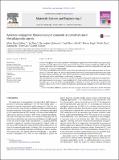Aptamer-conjugated, fluorescent gold nanorods as potential cancer theradiagnostic agents
Abstract
GNRs are emerging as a new class of probes for theradiagnostic applications thanks to their unique optical properties. However, the achievement of proper nanoconstructs requires the synthesis of highly pure GNRs with well-defined aspect ratio (AR), in addition to extensive surface chemistry modification to provide them with active targeting and, possibly, multifunctionality. In this work, we refined the method of the seed mediated growth and developed a robust procedure for the fabrication of GNRs with specific AR. We also revealed and characterized unexplored aging phenomena that follow the synthesis and consistently alter GNRs' final AR. Such advances appreciably improved the feasibility of GNRs fabrication and offered useful insights on the growth mechanism. We next produced fluorescent, biocompatible, aptamer-conjugated GNRs by performing ligand exchange followed by bioconjugation to anti-cancer oligonucleotide AS1411. In vitro studies showed that our nanoconstructs selectively target cancer cells while showing negligible cytotoxicity. As a result, our aptamer-conjugated GNRs constitute ideal cancer-selective multifunctional probes and promising candidates as photothermal therapy agents.
Citation
Gallina , M E , Zhou , Y , Johnson , C J , Harris-Birtill , D , Singh , M , Zhao , H , Ma , D , Cass , T & Elson , D S 2016 , ' Aptamer-conjugated, fluorescent gold nanorods as potential cancer theradiagnostic agents ' , Materials Science and Engineering: B , vol. 59 , pp. 324-332 . https://doi.org/10.1016/j.msec.2015.09.101
Publication
Materials Science and Engineering: B
Status
Peer reviewed
ISSN
0921-5107Type
Journal article
Description
Funding for this project was provided by the ERC grant StG242991.Collections
Items in the St Andrews Research Repository are protected by copyright, with all rights reserved, unless otherwise indicated.

